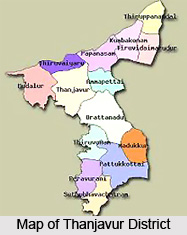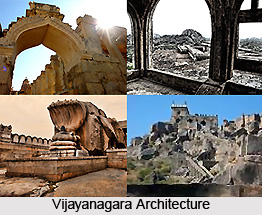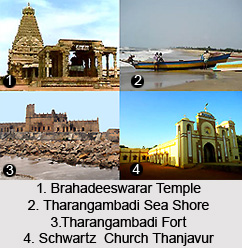 Thanjavur district is the rice bowl of the state of Tamil Nadu. The Big Temple and a number of other major temples in the district are known all over the world. The district of Thanjavur used to be the cultural capital of the country in 1790. It gained prominence during the period of the Chola Kings, who made Thanjavur their capital. Thereafter, it was ruled by the Nayakas and the Maratha Kings, who nurtured art and culture. The cultural, the architectural and the scholarly pursuits of these rulers are seen in the great monuments like Grand Anaicut, Big Temple and the Serfoji Mahal Library in the district. This district enjoys a fairly healthy climate which facilitates the visit of a large number of tourists to this district throughout the year.
Thanjavur district is the rice bowl of the state of Tamil Nadu. The Big Temple and a number of other major temples in the district are known all over the world. The district of Thanjavur used to be the cultural capital of the country in 1790. It gained prominence during the period of the Chola Kings, who made Thanjavur their capital. Thereafter, it was ruled by the Nayakas and the Maratha Kings, who nurtured art and culture. The cultural, the architectural and the scholarly pursuits of these rulers are seen in the great monuments like Grand Anaicut, Big Temple and the Serfoji Mahal Library in the district. This district enjoys a fairly healthy climate which facilitates the visit of a large number of tourists to this district throughout the year.
History of Thanjavur District
Thanjavur district stands separately from a long time for its agricultural activities and is rightly acclaimed as the granary of South India lying in the deltaic region of the famous Kaveri River and criss-crossed by lengthy network of irrigation canals. This coastal district is filled with tall coconut groves, green paddy fields, vast gardens of mango and plantain trees and other vegetation. A number of testimonials available in the ancient Tamil literature referring to the Kaveri as possessing the sanctity of the Ganges in conformity with the mythological and legendry stories attributed to its divine origin, rightly point the reason for which the river is popularly called the `Mother Kaveri` and its sacredness is evident from `Kaviri-Thala-Puranam`. The district of Thanjavur attained prominence under the Chola rulers who were paramount in South India during the 9th to the 13th centuries. The Chola dynasty became extinct in the beginning of the 12th century and it gave way to Pandyan supremacy. When the Pandyan Kingdom was in the thrones of civil war, the Muslim ruler Ala-ud-din Khilji, the Sultan of Delhi, took advantage of it and over powered the Pandyas and Thanjavur came under the Muslim rulers.
 Thanjavur remained under the supremacy of the Vijayanagar Kings for a long period. The Nayak dynasty was established during this period and Sevappa, the founder of Nayak Kingdom of Thanjavur made his appearance on the scene. The Thanjavur Nayaks were loyal to Vijayanagar after the battle of Talikotta and helped Vijayanagar in repulsing the attacks of the Nayaks of Madurai and their temporary ally Golkonda, but the beginning of the 17th Century saw the end of the Vijayanagar Empire. During the later half of the seventeenth century, the Marathas came to Thanjavur. Ekogi became the first Maratha ruler of Thanjavur (1676-1683). The Marathas ruled this district for some time but later became vassals of the Mughal Governor of Karnataka state. Thanjavur went into the hands of the English by the Treaty of 1799. The ruler of Thanjavur was allowed to retain the Thanjavur fort only with limited power of administration. When the ruler died in 1841 without any heir, the Thanjavur fort was also annexed by the British and it became part of the then Madras. The district of Thanjavur remained under the British rule until 1947 when India attained freedom.
Thanjavur remained under the supremacy of the Vijayanagar Kings for a long period. The Nayak dynasty was established during this period and Sevappa, the founder of Nayak Kingdom of Thanjavur made his appearance on the scene. The Thanjavur Nayaks were loyal to Vijayanagar after the battle of Talikotta and helped Vijayanagar in repulsing the attacks of the Nayaks of Madurai and their temporary ally Golkonda, but the beginning of the 17th Century saw the end of the Vijayanagar Empire. During the later half of the seventeenth century, the Marathas came to Thanjavur. Ekogi became the first Maratha ruler of Thanjavur (1676-1683). The Marathas ruled this district for some time but later became vassals of the Mughal Governor of Karnataka state. Thanjavur went into the hands of the English by the Treaty of 1799. The ruler of Thanjavur was allowed to retain the Thanjavur fort only with limited power of administration. When the ruler died in 1841 without any heir, the Thanjavur fort was also annexed by the British and it became part of the then Madras. The district of Thanjavur remained under the British rule until 1947 when India attained freedom.
Geography of Thanjavur District
The district is located between nine degree fifty minutes and eleven degree twenty five minutes on the North latitude and seventy eight degree forty five minutes and seventy nine degree twenty five minutes to the East longitude. The total area covered by this district of Thanjavur is 3396.57 square kilometers. The maximum temperature experienced by this district is 37.48 degree Celsius and the minimum temperature is 20.82 degree Celsius. The annual rainfall received by this district is 303.1 millimetres from the south-west monsoon and 953.2 millimetres from the north-east monsoon. The total area under cultivation in the district of Thanjavur is 241292 hectares and the major crops grown in this district are rice, millets, groundnut, pulses, cotton, sugarcane, etc.
 Climate of Thanjavur District
Climate of Thanjavur District
The climate of this district in the state of Tamil Nadu is termed as a fairly healthy one like other coastal areas. The month of November, December, January and February are the pleasant months in a year with climate full of warm days and cool nights. From the month of March onwards, the climate becomes sultry and the mercury reaches its peak by the end of May and June depending upon the set of summer rain. The North-East monsoon in the month of October brings complete relief. The South-West monsoon sets in June and continues till the month of September. Rainfall during this period in lower than that of North-East monsoon which sets in the month of October and it continues more or less till the month of February. However, this district is benefited more by North-East monsoon because of its heavy rainfall and the Western Ghats invariably feeds the Kaveri and helps greatly for the vast cultivation of the deltaic area.
The River Kaveri and a number of irrigation projects that have been carried out even from the days of Chola Kings can be regarded as the best irrigation system in the state of Tamil Nadu. In the erinaceous soil tracts in Pattukkottai, facilities of irrigation have been very useful. The requirement for irrigation was realized very early and irrigation systems of this district dates back to days of early Cholas. Today, Thanjavur district possesses one of the best irrigation systems in Tamil Nadu and ranks foremost in the area irrigated. More than seventy percent of the gross cropped area is under irrigation systems from one source or the other. The chief sources of irrigation in the district are rivers, a few rain fed tanks, wells and tubes wells. These wells and tanks located mostly in the upland regions. Kaveri and Coleroon are the major rivers in the district and as these rivers are fed by the south-west monsoon. Agriculture in this district is dependent on the River Kaveri as a majority of the irrigated areas derive water from Kaveri and its numerous branches. Thus, the River Kaveri is the chief source of irrigation in the district.
Tourism in Thanjavur District
The district of Thanjavur is famous for its temples. The Brihadeeswarar Temple is one of the well-known temples in this district. The temple was constructed by the great Chola King, Rajaraja Chola I in the 10th Century A.D. and it remains as an outstanding example of the Chola architecture. There is a palace near this temple which is a vast building of masonry constructed partly by the Nayaks around A.D. 1550 and partly by the Marathas. The palace holds an art gallery which preserves a number of granite and bronze statues of the Chola period. The Saraswati Mahal Library in the palace is the library where more than thirty thousand paper and palm leaf manuscripts in European and Indian languages are preserved.
Hall of Music
Hall of Music is an acoustically perfect ancient music hall which is in the Palace situated close to the Sri Brihadeeswarar Temple. The Palace garden holds the Schwartz Church which was constructed in A.D. 1779 by Rajah Serfoji in token of his affection for the Rev.C.V.Schwartz of the Danish mission. Another attraction of this district is the Sivaganga Tank which is located in close proximity to the palace. This tank is famous for its sweet water.
Tharangambadi
Tharangambadi is the coastal town in the district of Thanjavur which was previously a Danish settlement from 1624 to 1825. This place has two churches and a fort and forms one of the prominent places of tourist interest in this district. Kodikkarai is noted for its congregation of migratory water fowl, mainly flamingos from the month of November to January. Other wildlife like blackbuck and wild ponies are also seen here. The district of Thanjavur in the Tamil Nadu state witnesses several festivals. Festival on full moon days in the Tamil months of Adi which is from July to August and Thai which is from January to February, attract a large number of pilgrims from all parts of the state. Another major festival is the Maham Festival in Kumbakonam. It is celebrated in the months of February and March once in every twelve years.






